It’s the dead of winter in Stockholm and I’m sitting in a very small room inside the very inaptly named Calm Body Modification clinic. A few feet away sits the syringe that will, soon enough, plunge into the fat between my thumb and forefinger and deposit a glass-encased microchip roughly the size of an engorged grain of rice.
“You freaking out a little?” asks Calm’s proprietor, a heavily tattooed man named Chai, as he runs an alcohol-soaked cotton swab across my hand. “It’s all right. You’re getting a microchip implanted inside your body. It’d be weird if you weren’t freaking out a little bit.” Of Course It Fucking Hurts!, his T-shirt admonishes in bold type.
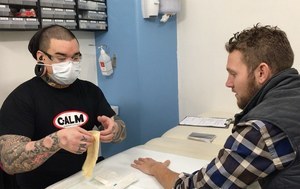
Chai and the writer at Calm Body Modification in Stockholm.
Anne Helen Petersen / BuzzFeed News
My choice to get microchipped was not ceremonial. It was neither a transhumanist statement nor the fulfillment of a childhood dream born of afternoons reading science fiction. I was here in Stockholm, a city that’s supposedly left cash behind, to see out the extreme conclusion of a monthlong experiment to live without cash, physical credit cards, and, eventually, later in the month, state-backed currency altogether, in a bid to see for myself what the future of money — as is currently being written by Silicon Valley — might look like.
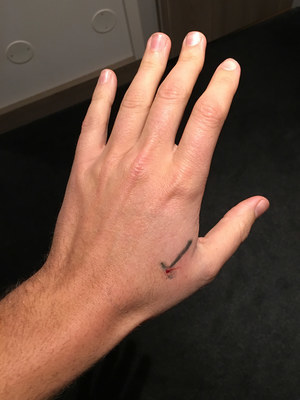
Charlie Warzel / BuzzFeed News
Some of most powerful corporations in the world — Apple, Facebook, and Google; the Goliaths, the big guys, the companies that make the safest bets and rarely lose — are pouring resources and muscle into the payments industry, historically a complicated, low-margin business. Meanwhile, companies like Uber and Airbnb have been forced to become payments giants themselves, helping to facilitate and process millions of transactions (and millions of dollars) each day. A recent report from the auditor KPMG revealed that global investment in fintech — financial technology, that is — totaled $19.1 billion in 2015, a 106% jump compared to 2014; venture capital investment alone nearly quintupled between 2012 and last year. In 2014, Americans spent more than $3.68 billion using tap-to-pay tech, according to eMarketer. In 2015, that number was $8.71 billion, and in 2019, it’s projected to hit $210.45 billion. As Apple CEO Tim Cook told (warned?) a crowd in the U.K. last November, “Your kids will not know what money is.”
To hear Silicon Valley tell it, the broken-in leather wallet is on life support. I wanted to pull the plug. Which is how, ultimately, I found myself in this sterile Swedish backroom staring down a syringe the size of a pipe cleaner. I was here because I wanted to see the future of money. But really, I just wanted to pay for some shit with a microchip in my hand.
The first thing you’ll notice if you ever decide to surrender your wallet is how damn many apps you’ll need in order to replace it. You’ll need a mobile credit card replacement — Apple Pay or Android Pay — for starters, but you’ll also need person-to-person payment apps like Venmo, PayPal, and Square Cash. Then don’t forget the lesser-knowns: Dwolla, Tilt, Tab, LevelUp, SEQR, Popmoney, P2P Payments, and Flint. Then you might as well embrace the cryptocurrency of the future, bitcoin, by downloading Circle, Breadwallet, Coinbase, Fold, Gliph, Xapo, and Blockchain. You’ll also want to cover your bases with individual retailer payment apps like Starbucks, Walmart, USPS Mobile, Exxon Speedpass, and Shell Motorist, to name but a few. Plus public and regular transit apps — Septa in Philadelphia, NJ Transit in New Jersey, Zipcar, Uber, Lyft. And because you have to eat and drink, Seamless, Drizly, Foodler, Saucey, Waitress, Munchery, and Sprig. The future is fractured.
This isn’t lost on Bryan Yeager, a senior analyst who covers payments for eMarketer. “This kind of piecemeal fragmentation is probably one of the biggest inhibitors out there,” he said. “I’ll be honest: It’s very confusing, not just to me, but to most customers. And it really erodes the value proposition that mobile payments are simpler.”
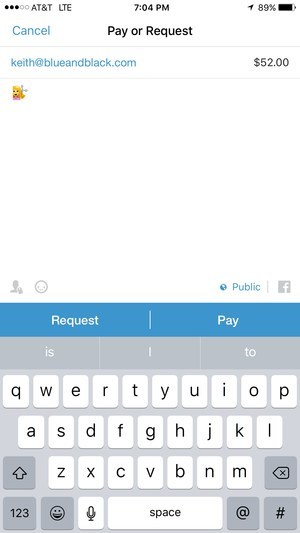
Venmo screenshot.
Charlie Warzel / BuzzFeed News
On a frigid January afternoon in Midtown Manhattan, just hours into my experiment, I found myself at 2 Bros., a red-tiled, fluorescent-lit pizza shop that operates with an aversion to frills. As I made my way past a row of stainless steel ovens, I watched the patrons in front of me grab their glistening slices while wordlessly forking over mangled bills, as has been our country’s custom for a century and a half. When my turn came to order, I croaked what was already my least-favorite phrase: "Do you, um, take Apple Pay?" The man behind the counter blinked four times before (wisely) declaring me a lost cause and moving to the next person in line.
This kind of bewildered rejection was fairly common. A change may be coming for money, but not everyone’s on board yet, and Yaeger's entirely correct that the "simple" value proposition hasn't entirely come to pass. Paying with the wave of a phone, I found, pushes you toward extremes; to submit to the will of one of the major mobile wallets is to choose between big-box retailers and chain restaurants and small, niche luxury stores. The only business in my Brooklyn neighborhood that took Apple Pay or Android Pay was a cafe where a large iced coffee runs upwards of $5; globally, most of the businesses that have signed on as Apple Pay partners are large national chains like Jamba Juice, Pep Boys, Best Buy, and Macy’s.
Partially for this reason, the primary way most Americans are currently experiencing the great fintech boom isn’t through Apple or Android Pay at all, but through proprietary payment apps from chains such as Target, Walmart, and Starbucks — as of last October, an astonishing 1 in 5 of all Starbucks transactions in the U.S. were done through the company’s mobile app. It wouldn’t be all that hard to live a fully functional — if possibly boring — cash-free consumer life by tapping and swiping the proprietary apps of our nation’s biggest stores.
If that doesn’t feel revolutionary or particularly futuristic, it’s because it’s not really meant to. But the future of mobile retail is assuredly dystopian. Just ask Andy O’Dell, who works for Clutch, a marketing company that helps with consumer loyalty programs and deals with these kinds of mobile purchasing apps. “Apple Pay and the Starbucks payment app have nothing to do with actual payments,” he told me. “The power of payments and the future of these programs is in the data they generate.”
"The power of payments is in the data they generate.”
Imagine this future: Every day you go to Starbucks before work because it’s right near your house. You use the app, and to ensure your reliable patronage, Starbucks coughs up a loyalty reward, giving you a free cup of coffee every 15 visits. Great deal, you say! O’Dell disagrees. According to him, Starbucks is just hurting its margins by giving you something you’d already be buying. The real trick, he argued, is changing your behavior. He offers a new scenario where this time, instead of a free coffee every 15 visits, you get a free danish — which you try and then realize it goes great with coffee. So you start buying a danish once a week, then maybe twice a week, until it starts to feel like it was your idea all along.
In that case, O’Dell said, Starbucks has "changed my behavior and captured more share of my wallet, and they've also given me more of what I want."
"That's terrifying," I told him.
"But that’s the brave new world, man," he shot back. "Moving payments from plastic swipes to digital taps is going to change how companies influence your behavior. That's what you're asking, right? Well, that's how we're doing it."
In this sense, the payments rush is, in no small part, a data rush. Creating a wallet that’s just a digital version of the one you keep in your pocket is not the endgame. But figuring out where you shop, when you shop, and exactly what products you have an affinity for, and then bundling all that information in digestible chunks to inform the marketers of the world? Being able to, as O’Dell puts it, “drive you to the outcome they want you to have like a rat in a maze by understanding, down to your personality, who you are”? That’s disruption worth investing in.
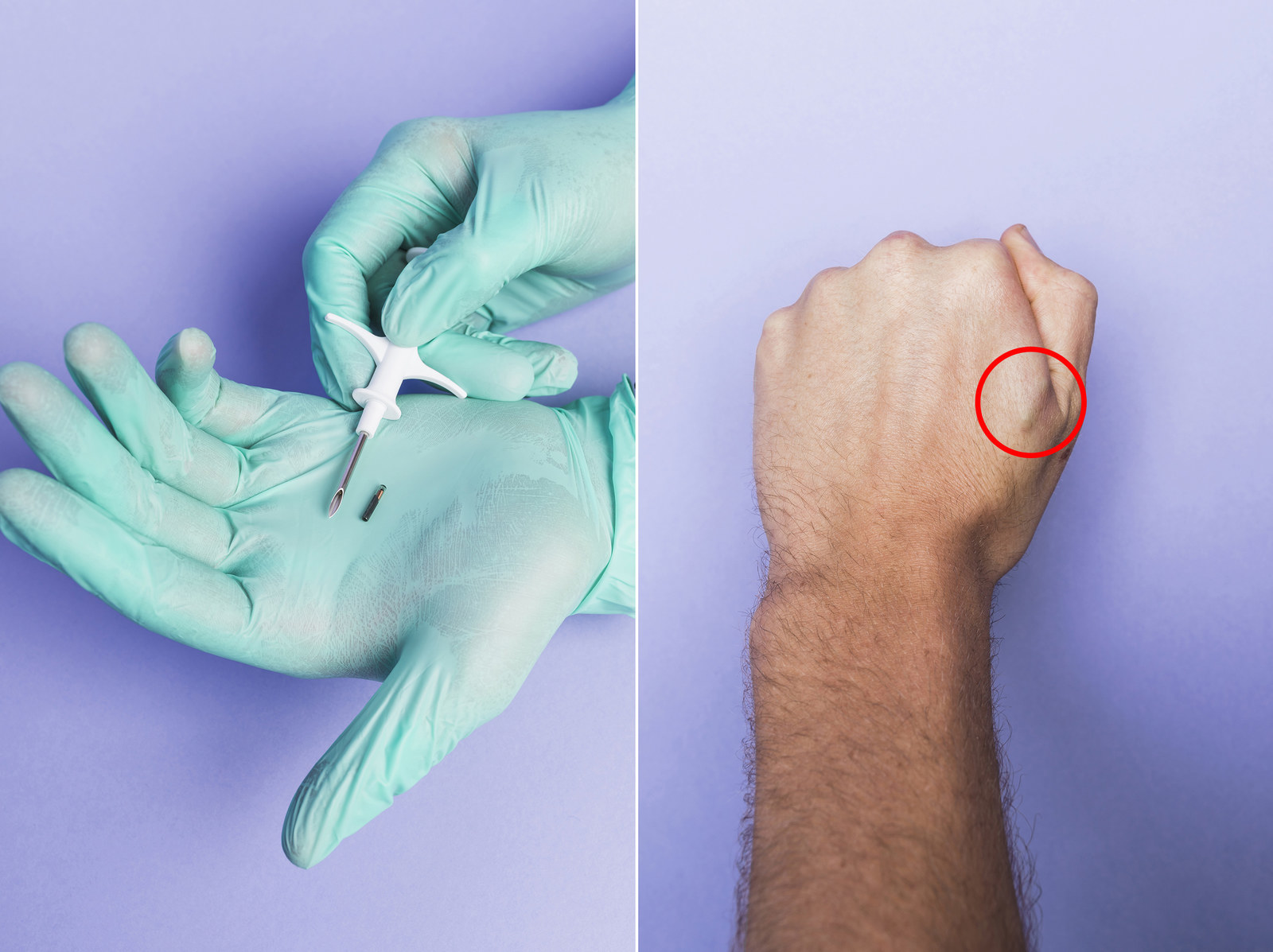
Jared Harrell / BuzzFeed News (2)
For all its complexity and bureaucracy and importance, money, at its core, is really just information. When FDR weaned the United States off the gold standard in 1933, cash, no longer backed by physical gold, became an abstraction. Today, that abstraction is pushed to new extremes: Not only does 92% of the money in the world exist as a series of ones and zeroes, but now it’s being transferred from place to place by any number of digital intermediaries looking to take a cut.
That process is complicated, but the key issue is trust. Money, argues David Wolman in The End of Money, is not much more than “a belief in a shared purpose, or at least a shared hallucination.” This faith in the “particular religion” of cash has been at the center of standardized currencies since Kublai Khan, and the loss of that faith has been associated with every major economic catastrophe in history. But trust — especially when it comes to new forms of currency — takes time to build.
The first two weeks of my experiment, most people balked when I offered an alternative means of payment. “I’m a little worried this might not go through in time,” one server at a German beer hall told me when I asked if I could Venmo her for my bill. A waiter at a different establishment scoffed when I tried to pay him or the restaurant via PayPal, suggesting his manager would think he was getting ripped off.
Yaeger sees this as standard for a nascent technology. “I kind of equate now to where things were 10 to 12 years ago with e-commerce,” he told me. “The concept of putting credit cards on a screen was new. Retailers and normal people were concerned about that. So innovative companies like PayPal and Amazon built that trust up over a decade while others slowly moved in.”
There are, of course, legitimate reasons not to trust these new forms of payment. Anyone who’s been mugged or lost a wallet knows cash is far from perfect, but this constellation of new digital payment products introduces a whole new category and scale of ways to get robbed, hacked, scammed, and screwed. Venmo — the social payment service that’s now transferring over $1 billion per month — may, in some ways, be the truest glimpse at a mobile payment future, but it’s not exactly entirely secure. Smartphones can be as easily lost and stolen as wallets, but they’re also eminently breakable, orders of magnitude more expensive, and obsolete after two or three years. And the payment-apps landscape is still such that living cashlessly in 2016 means entering your credit card information or routing number into dozens of stand-alone apps, some of which look as if they’ve been built overnight by a high school computer science class.

At the barbershop.
Charlie Warzel / BuzzFeed News
All this risk and all this friction, in the service of...what, exactly? “Plastic works really well,” Randy Reddig, an entrepreneur who was a part of Square’s founding team, told me, taking a shot at what he called “mobile wallet hysteria.” “I have a wallet right now in my pocket, and it’s great. It can feel like this is something that nobody is asking for. It’s solutioneering: Take something that exists just fine in the meatspace world and make it digital and somehow we’re all supposed to believe it’s better.”
To Reddig, the true future of payments is revealing itself inside many of Silicon Valley’s biggest new companies. Airbnb, he said, has one of the most sophisticated payments infrastructures of any company in the world, handling deposits and disbursements in hundreds of markets, many with different currencies. “All the innovation around payments is a means to an end — table stakes,” he said. “Uber has one of, if not the most used mobile payments methods in the world, and it was absolutely crucial — they had to do it to create the experience and service they wanted. Payment technology created certainty for riders and drivers that they’d get paid — it facilitated trust.”
Much as the true value of a retailer’s mobile payment app is in the metadata it gobbles up, the real power of digital payments lies in the largely invisible infrastructure that undergirds them. Fintech companies like Square aren’t exactly sexy, but they allow small businesses and individual merchants to process transactions without prohibitively expensive equipment or the fees that legacy credit companies charge.
"Millennials don't trust banks, but they trust Apple and Google."
“It’s about financial inclusion and serving real, normal people,” Reddig said. "There is a lot of opportunity to build very profitable businesses that operate better than incumbents in transparency, great design, great user experience. Millennials don't trust banks, but they trust Apple and Google."
This is already happening, just outside the U.S. If fintech’s true believers think it’ll fundamentally change the way we live, the developing world is where their vision is revealing itself most clearly. In Kenya, for example, the payment messaging service M-Pesa has attracted over 13 million monthly active users (out of a population of 44.3 million). As of last May, roughly 42% of Kenya’s GDP was transacted via M-Pesa, all without tying Kenyans to expensive, cumbersome bank accounts.
But more than that, M-Pesa has effectively invented a new form of credit that’s based on a history of reliable transactions from phone to phone, rather than through a bank. In a world where 2.5 billion people don’t have bank accounts, systems like M-Pesa are set to leapfrog Western banking the same way much of the developing world skipped the desktop and went straight to the smartphone for its computing needs. In reinventing money transfers, M-Pesa and its ilk offer more than a new way to pay — they are opportunity engines, offering the ability to build credit in a world that previously shut them out. And in the process, there are billions to be made in transfer fees.
By my third week, the cashless, frictionless future I’d hoped to live began to feel glitchy, burdensome, and alienating. I had to meticulously plan my every move hours or even days in advance — a haircut required me to convince my barber to start using Venmo, going out for a meal meant lining up a dining companion willing to submit to confused stares and drawn-out check-settling processes.
One January afternoon, I found myself trying to persuade a prodigiously bearded, flannel-shirt-wearing barista named Michael to allow me to pay him personally via Square Cash for a coffee, which he would then pay the register for. After a confession that this was all for a story from me and a pity laugh from him, Michael reached for his phone, but not before he locked eyes with me. “I’m only doing this because I want you to write about how much this sucks for us,” he said. He went on to talk about a popular coffee app called Cups, which allows customers to order and pay all inside the phone. “It’s like, now everyone who comes in is a robot — they just stare at their phone and wait to have their name called. Nobody even looks at us,” he said.
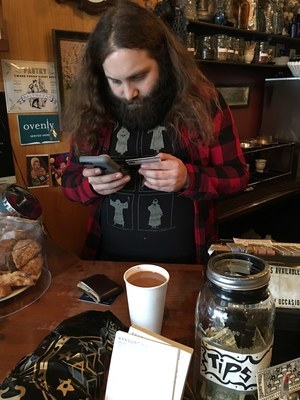
Michael, barista.
Charlie Warzel / BuzzFeed News
from BuzzFeed - Tech https://www.buzzfeed.com/charliewarzel/yes-we-scan?utm_term=4ldqpia
No comments:
Post a Comment